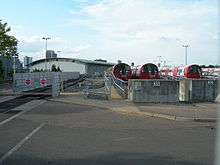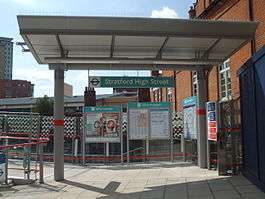Stratford High Street DLR station
| Stratford High Street | |
|---|---|
|
Northern entrance soon after opening | |
 Stratford High Street Location of Stratford High Street in Greater London | |
| Location | Stratford |
| Local authority | London Borough of Newham |
| Managed by | Docklands Light Railway |
| Number of platforms | 2 |
| Accessible | Yes |
| Fare zone | 2 and 3 |
| DLR annual boardings and alightings | |
| 2012 | 0.944 million[1] |
| 2013 |
|
| 2014 |
|
| 2015 |
|
| Key dates | |
| 14 June 1847[3][4] | Opened as Stratford Bridge |
| 1 November 1880 | renamed Stratford Market |
| 1892 | Station resited |
| 1898 | renamed Stratford Market (West Ham) |
| 1923 | renamed Stratford Market |
| 6 May 1957 | Closed |
| 31 August 2011 | DLR station opened on site of the former station[5] |
| Other information | |
| Lists of stations | |
| WGS84 | 51°32′16″N 0°00′02″W / 51.5379°N 0.0006°WCoordinates: 51°32′16″N 0°00′02″W / 51.5379°N 0.0006°W |
|
| |
Stratford High Street DLR station is a Docklands Light Railway station in the Stratford neighbourhood of the London Borough of Newham, in east London, England. It is located on the Stratford International extension of the Docklands Light Railway,[6] which opened on 31 August 2011.[7] The site was the location of an earlier railway station from 1847 to 1957, known initially as Stratford Bridge and later as Stratford Market.
History
The first station on the site was opened as Stratford Bridge on 14 June 1847 on the Eastern Counties and Thames Junction Railway[3] (ECR) between Stratford and Canning Town stations. By the 1860s the railways in East Anglia were in financial trouble, and most were leased to the ECR; they wished to amalgamate formally, but could not obtain government agreement for this until 1862, when the Great Eastern Railway (GER) was formed by amalgamation. Thus Stratford Bridge became a GER station in 1862.[8]
The station served a local fruit and vegetable market and was renamed Stratford Market on 1 November 1880.[3]
The station was resited in 1892 when the line was widened.[3] On the westbound platform there was a tower that contained steps that allowed direct access over the goods lines to the adjacent Great Eastern Railway's printing works which opened in 1893.[9] As of 2016 this building is still extant.
Following the 1923 grouping the station was operated by the London & North Eastern Railway.
The second station was itself renamed twice: to Stratford Market (West Ham) in 1898, resuming the name Stratford Market in 1923.[3]
Following nationalisation of the railways in 1948 the station became part of British Railways Eastern Region.
The East Coast floods of 31 January 1953 saw tracks in the station flooded.[10] The station closed on 6 May 1957[3] due to lack of traffic and the proximity of the larger Stratford station, which was also served by other lines.
The line through the station site to North Woolwich closed in 2006 for works to start on conversion to DLR operation, reopening as part of the Stratford International extension on 31 August 2011.
1905 collision
On 5 April 1905 two trains collided just north of Stratford Market station. At this time there were several junctions between Stratford Low Level platforms and Stratford Market station and a goods train was making a move from the Western Curve to the Goods Lines at Stratford Market. An empty coaching stock train was stopped at Stratford Market station awaiting a path towards Stratford Low Level when the driver, thinking he had the right to proceed, started the train having failed to properly check the signals were set against him.
The two trains collided on the junction directly north of the station with the goods engine overturning and killing its fireman William Secker, who was crushed under the locomotive after jumping off.[11][12]

Design
The red brick station buildings from the original station still stand on the south side of Stratford High Street.
The station is located on Stratford High Street. It is provided with footbridge connections to Bridge Road and Burford Road in order to provide access to the surrounding areas. In order to locate the station here part of Bridge Road has been permanently closed to vehicles except for emergency access, and access into Burford Road from the A118 blocked. This avoided the need to take land from Rokeby School whilst also enabling the station to be located close to Stratford High Street.[13]
Services

Off-peak, trains run every ten minutes to between Stratford International to the North and Woolwich Arsenal to the South. In the peak hours trains run every eight minutes between Stratford International and Woolwich Arsenal.[14]
Goods depot
A large goods depot was located south of the station on the western side of the line. This opened in 1879 for "potatoes, roots, hay and straw" and served the market. Additionally there was a coal depot and a siding which served the Patent Victoria Stone Works. In 1907 the market depot became the centre for the distribution of bananas in London with Fyfes and Elders both having depots on the site. Around this time the depot had capacity for 400 wagons (a standard wagon being 21 feet (6.4 m) long). The depot closed in the 1960s although the sidings were used for storage of withdrawn rolling stock for a number of years afterwards.[15]
Stratford Market depot
The opening of the Jubilee line extension in 1990s saw the site used as a depot for the rolling stock that works the line (the rest of the lines rolling stock is maintained at Neasden). The principal depot building opened in 1996 designed by Chris Wilkinson Architects and features a 100-metre (330 ft) wide by 190-metre (620 ft) long arched roof that covers 11 maintenance roads.[16]

Buses
London Buses routes 25, 276, 425 and D8 and night route N8 serve the station.
References
- ↑ Transport for London (12 February 2013). "Freedom of Information DLR usage 1213". Transport for London. Retrieved 10 November 2013.
- 1 2 3 "Up-to-date DLR entry/exit statistics for each station" (XLSX). What Do They Know. Transport for London. 18 March 2016. Retrieved 2 April 2016.
- 1 2 3 4 5 6 Butt, R.V.J. (1995). The Directory of Railway Stations. Yeovil: Patrick Stephens Ltd. p. 222. ISBN 1-85260-508-1. R508.
- ↑ "STRATFORD MARKET". Retrieved 3 February 2009.
- ↑ "Docklands Light Railway extension marks one year to go to the London 2012 Paralympic Games". Retrieved 31 August 2011.
- ↑ "Docklands Light Railway - Stratford International Extension". DLR. Retrieved 28 October 2010.
- ↑ "Docklands Light Railway opens to Stratford International". Railway Gazette International. 31 August 2011.
- ↑ Vaughan, Adrian (1997). Railwaymen, Politics and Money. London: John Murray. pp. 134, 135. ISBN 0 7195 5150 1.
- ↑ Connor, J E (2001). Branch Lines around North Woolwich. Midhurst UK: Middleton Press. pp. 22,25. ISBN 1 901706 65 6.
- ↑ Kenworthy, Graham (January 2013). "East coast floods January 1953". Great Eastern Journal (153): 5.
- ↑ Board of trade (UK). "Accident report" (PDF). Railwaysarchive.co.uk. Board of Trade (UK). Retrieved 7 June 2014.
- ↑ Ashton, Geoff; Challis, David (October 2013). "Collision at Stratford Market". Great Eastern Journal. 156: 4–13.
- ↑ "DLR - Current Projects - Railway Extensions - Stratford International - Stations". Retrieved 2014-11-29.
- ↑ "DLR frequencies". Transport for London. Retrieved 7 February 2012.
- ↑ Watling, John (January 1985). "London Goods stations of the Great Eastern Railway Part 3". Great Eastern Journal (41): 4–5.
- ↑ "Stratford Market Depot". Wilson Eyre Architects. Retrieved 30 December 2013.
External links
| Wikimedia Commons has media related to Stratford High Street DLR station. |
| Preceding station | Following station | |||
|---|---|---|---|---|
towards Stratford International | Docklands Light Railway | |||
| Disused Railways | ||||
| Stratford | Great Eastern Railway Palace Gates Line |
Canning Town | ||
